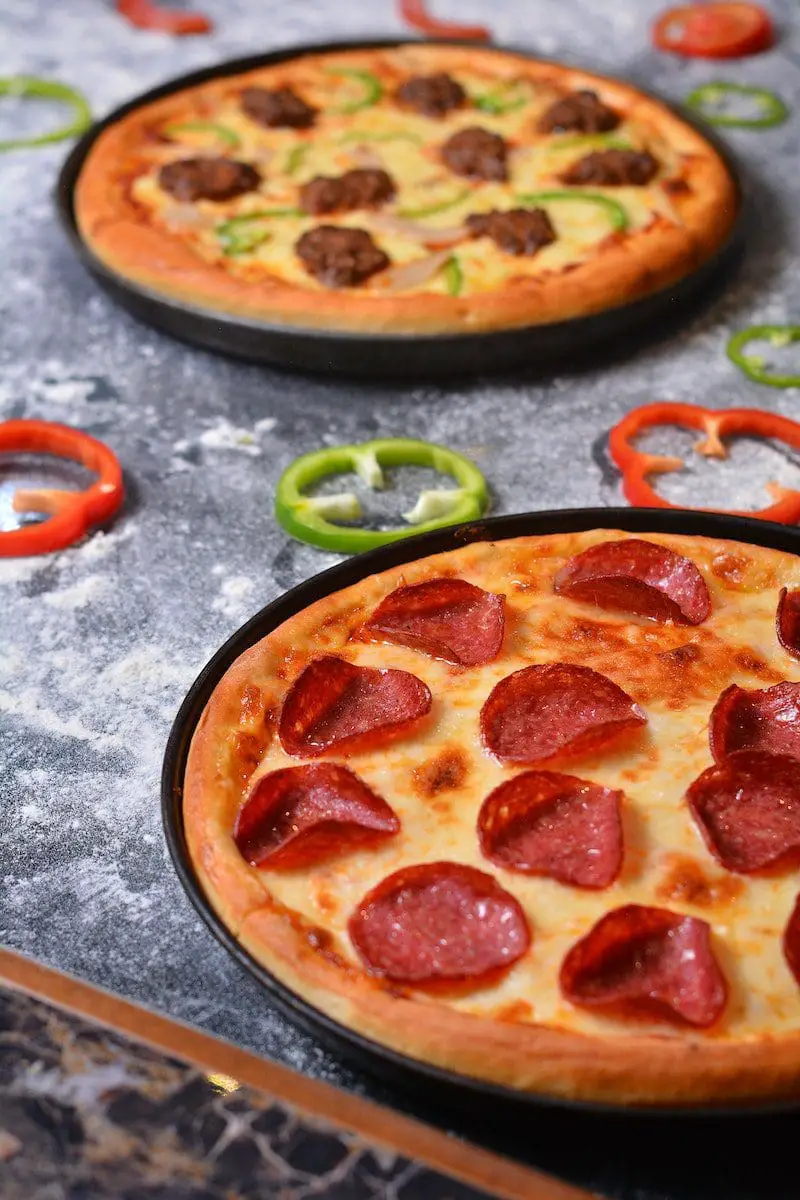Food is something that vanishes the diversity among people; it makes people closer. It has no boundary; every country or region has its specialty.
For example, in a country like India, known for its diversity, many varieties of food change according to different regions. The propagation of food probably depends on the propagation of Peepal, for example, in countries like Canada USA, Russia, etc.,
Indian food is available due to the people residing there. Likewise, India has a variety of food like burgers, pizzas, pasta, etc., due to the influence of Western culture in the country. Pizzas have different varieties in their crust, topping, sauces, etc. There are a large number of varieties offered by different brands.
Key Takeaways
- Hand-tossed pizza features dough manually stretched and shaped by hand, resulting in a thin crust in the center and thicker around the edges.
- Pan pizza is made by placing the dough in a deep, round pan with raised edges, creating a thicker, chewier, and crispier crust on the bottom.
- The primary differences between hand-tossed and pan pizza lie in their crust thickness, texture, and preparation method. The hand-tossed is thinner and more irregular, while pan pizza has a thicker, uniform crust.
Hand-Tossed vs. Pan
The difference between Hand-tossed and pan is the crust’s taste and texture. People prefer any crust as they find both of them pretty similar to each other, but they are not the same.

Comparison Table
| Parameters of Comparison | Hand-tossed | Pan |
|---|---|---|
| Another name | Neapolitan pizza | Chicago- style |
| Texture | Dry and crispy | Soft and moist |
| Tools | Pizza peel and burning hot pizza stone | Deep baking tray |
| Origin | Italy | Chicago |
| Temperature | Approximately 500 degrees Fahrenheit | Higher than 500 degrees Fahrenheit |
What is Hand-tossed Pizza?
Hand-tossed is a method of preparing pizza base crust. In this particular method, the dough is tossed in the air to make the crust soft.
This procedure makes the pizza crust soft and fluffy as the air aerates with the dough. The dough is kneaded soft beforehand and then tossed in the air by the chef.
Although the dough is kneaded soft, it should not be slender. The dough is prepared with refined flour, yeast, salt, and water.
Hand-tossed pizzas are also considered Neapolitan pizzas. So, to get a perfect Neapolitan pizza, the perfect measurement of ingredients and method to prepare the dough is necessary.
Hand-tossed pizzas always need a professional technician to be tossed. There are specifications for tossing the dough to make it fluffy.
The Neapolitan hand-tossed pizzas are chewy and soft in texture. It is a regular dough, just like any other pizza dough, but the tossing technique makes it different.
If the dough is not tossed properly, it might result in a lumpy base.
Tossing the dough in the air makes it aerated, making the crust comparatively thinner than the pan pizzas. Hand-tossed pizzas have distinct edges too.
Also, the hand-tossed pizzas are dry and have blistered crusts. Hand-tossed techniques require tools, too; in tools, they need burning hot pizza steel or stone, and to transfer the dough, a pizza peel is required.
Once the dough is tossed in the air, it is spread, and toppings are added after giving it to rest. Then the pizza is sent to the oven for approximately 10 minutes at 500 degrees Fahrenheit.

What is Pan Pizza?
Pan is a style of pizza in which it is prep hatred within the pan. Unlike the hand-tossed, it does not require tossing. Pan pizzas were first introduced in Chicago. Thus, they are also known as Chicago- style pizza.
It is a deep dish and hence also known as deep-dish pizza. The procedure of pan pizzas is extremely different from hand-tossed pizzas; the dough is divided into smaller balls which are rolled and spread into the pan directly.
And it is then half-baked in the oven. Then on the half-baked base, other toppings are done.
Pan pizzas are easy to prepare and do not require any expertise. The dough needs to be adjusted in any baking tray with depth.
With simple pressing and poking, the oiled dough is spread in the tray. Pan pizzas have a thick crust with a bread-like texture and are deep, approximately 1 inch.
This pan base will allow more toppings to settle on with some extra cheese. The dough of pan pizzas is prepared extremely soft and hydrated.
The dough’s moisture is provided through oil and more water during kneading. Some amount of sugar is also added to the dough.
The pan pizza is baked for approximately 15 minutes, and the temperature is higher than that of the hand-tossed pizzas; to make the crust crispy, it is advisable to oil the pan beforehand. The taste of the pizza base differs from the toppings because things are almost similar in every pizza.
Pan pizzas are tastier even when cooked at home in a regular oven.

Main Differences Between Hand-tossed and Pan
- Hand-tossed is tossed first and then transferred to the pan. On the other hand, pan pizza base dough is directly spread into the pan.
- Hand-tossed is drier, whereas pan is moist in texture.
- Hand-tossed is baked at 500 degrees Fahrenheit. On the contrary, the pan is baked at a higher temperature.
- Hand-tossed requires expertise, but the pan base requires no expertise as it is easy to prepare.
- Hand-tossed requires different tools like pizza peel and burning hot pizza stone, but pan pizza does not require special tools.
- Hand-tossed makes a thin and crispy base, whereas pan makes a thick and bread-like fluffy texture.


The detailed explanations of the dough preparation for hand-tossed and pan pizzas are enlightening. It’s a testament to the craftsmanship and precision that goes into creating each type of crust.
Indeed, the dough preparation plays a vital role in determining the texture and flavor profile of the finished pizza. It’s an art form in itself.
Absolutely, understanding the nuances of dough preparation is essential for making exceptional hand-tossed and pan pizzas.
The article provides an in-depth exploration of the characteristics and attributes of hand-tossed and pan pizzas. It’s a comprehensive guide for anyone interested in the art of pizza-making.
The detailed examination of pizza crust preparation techniques offers valuable insights into the art and science of creating exceptional pizzas.
I agree, Grace Ward. It’s an insightful resource for pizza enthusiasts who seek to understand the nuances of different pizza styles.
I find the historical context of pan pizza’s origin in Chicago particularly intriguing. It adds a cultural element to the discussion of pizza styles.
Exploring the historical roots of pizza styles sheds light on the diverse culinary heritage of various regions. It’s a fascinating aspect to consider.
The cultural and regional influences on different styles of pizza highlight the rich culinary traditions associated with each type of pizza.
I disagree that pan pizzas do not require any expertise. While the method may be different, achieving the perfect pan pizza with the right texture and toppings also requires skill and knowledge.
I agree, Carrie94. Creating an exceptional pan pizza with the desired depth, texture, and flavors is an art in itself.
Pan pizza does have its challenges, and mastering the balance of ingredients and cooking time is crucial to achieving the perfect outcome.
The article effectively captures the nuances and subtleties of hand-tossed and pan pizzas, providing readers with a comprehensive understanding of the diverse elements that shape each pizza style.
Indeed, the thorough examination of pizza crust characteristics and preparation methods deepens one’s appreciation for the art of pizza-making.
The comparison table provides a clear and concise summary of the key differences between hand-tossed and pan pizzas. It’s well-structured and informative.
Absolutely, the detailed comparison makes it easier to understand and appreciate the unique characteristics of each type of pizza crust.
The details about the textural differences between hand-tossed and pan pizzas are enlightening. It’s intriguing to see how variations in preparation methods can result in diverse sensory experiences.
The sensory nuances described in the article demonstrate the level of precision and expertise required to achieve the desired texture and flavor in hand-tossed and pan pizzas.
Absolutely, understanding the impact of preparation techniques on the final texture of the crust enhances one’s appreciation of the art of pizza-making.
I appreciate the detailed description of the differences between hand-tossed and pan pizza. It’s interesting to learn about the origins and unique characteristics of each style.
Yes, it’s fascinating to see how different techniques and ingredients result in such distinct pizza styles.
The emphasis on precision and expertise in crafting hand-tossed and pan pizzas highlights the artisanship and skill required to achieve culinary excellence.
Absolutely, the meticulous attention to detail in dough preparation and cooking methods elevates the craft of pizza-making to an art form.
The dedication to precision and expertise in pizza preparation reflects the commitment to upholding culinary traditions and creating exceptional dining experiences.
I appreciate the scientific approach to describing the characteristics of hand-tossed and pan pizzas. It adds a layer of depth to the discussion of pizza crusts.
Yes, the scientific perspective provides a richer understanding of the chemical and physical processes that influence the texture and flavor of pizza crusts.
The scientific analysis of pizza crust preparation techniques underscores the complexity and precision involved in crafting distinct pizza styles.